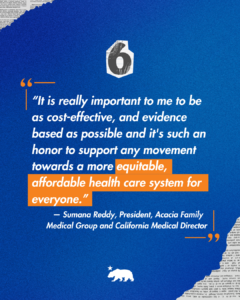California consumers and local leaders support Governor Newsom’s updates to the Office of Health Care Affordability
What you need to know: The Office of Health Care Affordability (OHCA) recently adopted strategies to bring down health care costs and improve access to care.
Sacramento, California – Established in 2022 by Governor Gavin Newsom, the Office of Health Care Affordability (OHCA) is charged with keeping prices in line with inflation, promoting high value care, and assessing market consolidation. Under the instructions of Governor Newsom, OHCA has met several important milestones and set forth new goals to help ensure that all Californians receive health care that is accessible, affordable, equitable, high-quality, and universal. These actions have been met with huge support from local leaders and consumers alike.
“It is a top priority of my administration to ensure that quality health care is available and affordable for all Californians. Increasing price and quality transparency, developing specific strategies and targets for the health care industry, and imposing financial consequences for entities that fail to meet our targets are all necessary steps to reign in health care costs. I am grateful for the work being done by the Office of Health Care Affordability and proud to see that leaders and patients across California are seeing promising results.”
Governor Gavin Newsom
Major accomplishments and milestones
1. After extensive public engagement, the Health Care Affordability Board recently approved a 3% statewide health care spending target for California starting at 3.5% for 2025 and 2026, lowering to 3.2% for 2027 and 2028, and reaching 3% for 2029. Due to its enforcement provisions, California’s law is viewed as the strongest in the country of its type.
2. The Board approved standards to move the health care system away from traditional fee-for-service payments and toward value-based models that incentivize equitable, high-quality, and cost-efficient care.
3. The Office adopted regulations that require reporting and allow the review of proposed mergers and acquisitions within the health care delivery system; such market consolidations/transactions could hurt competition, access, and affordability in California.
4. The Office will establish Workforce Stability Standards to monitor the effects of spending targets on the stability of the health care workforce.
Upcoming goals and objectives
1. Examining regional variations in health care costs in California starting with a public hearing in Monterey County in August 2024 in response to consumer concerns about high costs. Highlighting these disparities allows for a better understanding of the root causes of these disparities, such as lack of competition in a regional market, insurer practices and differential provider practices that could drive up costs.
2. Adopting a threshold for spending on primary care, which does not now exist.
What they’re saying
Individual Consumers

“Like many Californians, I’m drowning in the high cost of living, and healthcare feels like a luxury I can barely afford. Choosing between keeping a roof over your head and caring for your health should be easy. We deserve better, and California deserves better. This target makes sure that health care costs don’t outpace what every day Californians like myself can afford.” – Eric Devezin
“When they [providers] talk about budgets … I too have a personal budget that I do what I can to make it. And that (budget is) not going to the hospitals, not going to the doctor, but I’m still paying my healthcare just in case I get cancer or something very life-threatening. But for the day to day, I don’t access healthcare, because of the costs. So, with all due respect for your budgets, I too have a budget and you disrespect mine by charging me this much.” – Jen Villa, Salinas High School Teacher
“I really appreciate the progress we’ve made in California and around the country to make healthcare and prescription medication more affordable, as well as current programs already in place to help people but there is still much more work to do, because is totally unethical for pharmaceutical companies to price gouge and make outrageous profits off the backs of suffering Americans. I support the Office of Health Care Affordability’s suggested statewide spending target.” – Sydney Pitcher
Consumer Advocates

Researchers

Unions

Payers

Providers

“What drew me to this work is that I believe in the overarching goal of increasing access to quality, affordable, health care in California and frankly nationally as well, and I’m quite passionate about the ways that that can be done.”
– Barry Arbuckle, President and CEO, MemorialCare
APM/Workforce Stability/Primary Care

“I am grateful to HCAI and OHCA for the conscientious approach to bringing stakeholders and technical experts together in an inclusive, public process to develop well-informed and well-considered definitions for primary care measurement and an ambitious, desperately needed spending target for primary care.”
– Kevin Grumbach, MD, Professor, UCSF Department of Family and Community Medicine
“CMA is overarchingly supportive of OHCA’s proposed recommendations for the APM Standards for Payer-Provider Contracting. These proposed standards provide a framework that is based on quality, aims to reduce health care costs, and incentivizes primary and preventative care, all while meaningfully engaging physicians in multiple specialties and modes of practice.”
– Janice Rocco, Chief of Staff, California Medical Association
